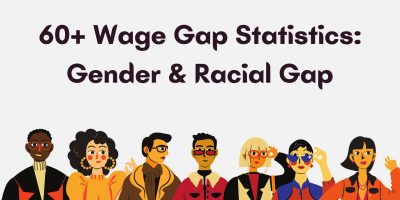
60+ Wage Gap Statistics in 2024: Gender & Racial Gap
Uncover wage gap statistics, highlighting the persistent inequality faced by minority workers and women, emphasizing the urgent need for transformative change in the workforce.


Head of People at Goose Chase
As organizations strive for growth and success in the modern economy, creating a good workplace culture is a must. And since the company’s culture has always been crucial in attracting and retaining talent, it’s up to HR and leadership to facilitate it. However, HR professionals might struggle with the dilemma: should they hire for culture add vs culture fit?
In the 1980s, when office culture started gaining ground, companies became more intentional about it.
Managers deliberately hired for culture and value fit. They favored candidates who would fit in the office and share the company’s values. With time, they focused more on personal attributes than skills and qualifications. It became more critical whether “He/She seems just like us!” instead of whether they have something new to bring to the team.
However, today many recruiters have steered away from culturally fit candidates.
They realize that hiring to suit a culture reinforces bias and unwanted behavior. Moreover, it poses a risk of losing great talent from diverse talent pools and hinders innovation in the company. Instead, they look for workers who will add to the company’s culture.
This article will explore the difference between culture and value fit employees vs. culture add employees and provide insight on whether hiring for culture add or culture fit is better.

Whether a candidate would be an excellent suit for a company depends solely on its culture. The cultural fit employee has values, beliefs, and behaviors that are compatible with those of the organization.
According to BBC, hiring managers heavily favor culturally fit workers.
In fact, a Robert Walters whitepaper found that 90% of employers believe it’s essential to find candidates who fit an organization’s values and beliefs, with 46% of them engaging recruitment firms to identify the qualities required for cultural fit. If those numbers look high, that’s because they are. The question is, why?
According to the whitepaper, 81% of hiring managers believe that a good-fit employee is less likely to leave. Moreover, 85% think that person will perform better.

However, it’s not only employers who see the importance of matching with a culture. 97% of professionals agree that they should fit with their company’s culture. But the 73% who didn’t feel that way left their jobs. Those who decided to quit quietly did so because they thought that the incompatibility impacted them at work. They found it makes them feel frustrated (64%), demotivated to work (74%), and stressed (60%).
Nevertheless, there are benefits to having employees who match the business’ culture well. A meta-analysis by Kristof and Brown found that good-fit workers are more satisfied with their jobs. Because of that, they also exhibit higher levels of productivity.
In addition, they identify more with their company, making them more committed and less likely to leave. It seems that 81% of the hiring managers in the Rober Walter whitepaper were indeed correct.
The meaning of culture fit is challenging to describe. It is the belief that for a business to be successful, its employees must identify with its culture. It is a way for companies to assess if a potential candidate is suitable for their particular environment. Thus that makes them likely to thrive in the role and contribute positively to team dynamics.
Cultural fit goes beyond technical skills.
It also involves considering how much an individual aligns with organizational philosophies and priorities. It also regards whether or not their attitudes, work ethics, communication styles, personality traits, etc., will complement existing staff members.
By considering these factors during the hiring process, organizations can ensure that new hires have the capabilities and shared values necessary for success within the company culture.
Assessing culture fit is challenging since there is no objective way to do it. Before measuring whether a candidate would be suitable, hiring professionals must be sure that they understand their organizational culture.
The next step is to create a cultural assessment strategy supported by modern recruiting software.
One way of measuring suitability is by conducting interviews with job applicants. Recruiters should ask questions to assess their employee persona and how well they could fit into the culture.
Another method for is through pre-employment assessments. These include personality and skill tests, allowing employers to identify fitting candidates quickly.
Regardless of which method they choose, recruiters must be aware of the potential bias each creates.
The meaning of culture fit is challenging to describe. It is the belief that for a business to be successful, its employees must identify with its culture. It is a way for companies to assess if a potential candidate is suitable for their particular environment. Thus that makes them likely to thrive in the role and contribute positively to team dynamics.
Cultural fit goes beyond technical skills.
It also involves considering how much an individual aligns with organizational philosophies and priorities. It also regards whether or not their attitudes, work ethics, communication styles, personality traits, etc., will complement existing staff members.
By considering these factors during the hiring process, organizations can ensure that new hires have the capabilities and shared values necessary for success within the company culture.
Assessing culture fit is challenging since there is no objective way to do it. Before measuring whether a candidate would be suitable, hiring professionals must be sure that they understand their organizational culture.
The next step is to create a cultural assessment strategy supported by modern recruiting software.
One way of measuring suitability is by conducting interviews with job applicants. Recruiters should ask questions to assess their employee persona and how well they could fit into the culture.
Another method for is through pre-employment assessments. These include personality and skill tests, allowing employers to identify fitting candidates quickly.
Regardless of which method they choose, recruiters must be aware of the potential bias each creates.
When hiring managers review applications or set up an ATS to evaluate resumes, their first focus might be the candidates’ skills and experiences. However, during the interview process, the job seeker’s personality also plays a significant role.
The “funny” colleague in the office or the one that boosts the dev team’s mood during a sprint is known as the “personality hire.”
Even though it’s improbable that managers would choose someone with a great personality and no skills, they will assess how much the candidate’s personality fits with the company’s culture. And in some cases, they might even decide to go with a personality hire if they believe the candidate’s personality would be the perfect match for the team.

A value fit employee fits the company’s core values and overall mission.
Value fit employees understand what it takes to succeed in their role and how they can contribute to the greater good of the business. Their main driver is a strong sense of purpose and they are eager to learn and grow within the organization.
Hiring value fit employees is beneficial because they share similar values with existing team members. This makes it easier for them to build relationships and work together effectively.
According to a Qualtrics’ survey, these individuals (72%) feel greater personal accomplishment from their work and are more likely to recommend their firm as a great workplace (70%).
The debate over whether a culture add or a culture fit hire is better for a company seems to be everlasting. Ultimately, it depends on what the company is looking for in the new employee. Nevertheless, both profiles have pros and cons.
A culturally fit employee might be a better choice if a business is looking for someone who will get along well with colleagues and understand the work environment, team dynamics, and the company’s values.
When the candidate’s beliefs and values align with the organization’s, they’ll be more satisfied and engaged with their jobs. In fact, Qualtrics’ survey found that 56% of job seekers don’t want to work in a company whose values differ from theirs.
Having similar personalities among team members makes them likelier to get along better. However, there is a greater risk of creating a homogeneous workforce lacking diverse viewpoints and new ideas.
Whereas culture fit hires suit a company’s cultural mold, culture add hires change the mold’s shape for the better.
If done right, hiring for culture add raises the company’s potential for innovation.
It creates diverse teams with a tremendous capacity for transformation and new ideas. Research that appeared in HBR found that businesses with diverse workforces are 45% more likely to report market share growth. Additionaly, they are 70% more likely to have captured a new market.
Hiring for culture add allows companies to dig deeper into the talent pool. According to SHRM, the best way to avoid biases is to create a structured interviewing approach. Firms must develop an ideal candidate profile that will serve to evaluate whether the interviewee would be successful in the position. A recruiting CRM can be of great help.
Though hiring for culture fit may have been a good strategy initially, it has gone awry. It is often fraught with bias and can dismiss those who do not fit the mold.
Unfortunately, there is still a culture fit bias among recruiters who tend to favor candidates more similar to a company’s status quo, and evidence proves that.
For instance, research by Richie Zweigenhaft found that the percentage of white male Fortune 500 CEOs in the last two decades dropped by only 10.6%, from 96.4% to 85.8%, remaining the dominant group in the C-suite.
Additionally, the “Meeting The World’s Midcareer Moment” report found that recruiters have a strong perception bias against candidates aged 45 or more, thinking they have poor skills and aren’t adaptable. In fact, only 15% consider a 45+ old job seeker a good cultural fit.
According to Natasha Delisle-Barrow, Head of People at Goosechase,

If a company’s goal is to continuously grow and improve and reach and expand to new markets, it needs to hire employees who will contribute towards that goal. Such workers have to be diverse thinkers and think outside of the box.
To find such employees, HR professionals need to steer away from the belief that those who fit the culture would be more suitable for the position.

Even though both culture add and culture fit hiring methods have advantages, in today’s modern economy, faced with a labor shortage, employees who add to an organization’s culture can be more beneficial.
As Natasha Delisle-Barrow puts it, “Culture add is a signal to prospective employees that a future employer is progressive, inclusive, future-ready and dynamic.”
Content Writer at Shortlister
Browse our curated list of vendors to find the best solution for your needs.
Subscribe to our newsletter for the latest trends, expert tips, and workplace insights!

Uncover wage gap statistics, highlighting the persistent inequality faced by minority workers and women, emphasizing the urgent need for transformative change in the workforce.

Explore the experiences of people of color with disabilities in the workplace as they shed light on the inequalities that arise due to ethnic, disability-related, and socioeconomic characteristics.

As the work landscape is changing, how can executive leadership help businesses adapt, excel, and drive organizational growth?

Transform your workplace into an inclusive and empowering environment for women with these eye-opening statistics. Unlock the potential of gender diversity and drive positive change in your organization.
Used by most of the top employee benefits consultants in the US, Shortlister is where you can find, research and select HR and benefits vendors for your clients.
Shortlister helps you reach your ideal prospects. Claim your free account to control your message and receive employer, consultant and health plan leads.